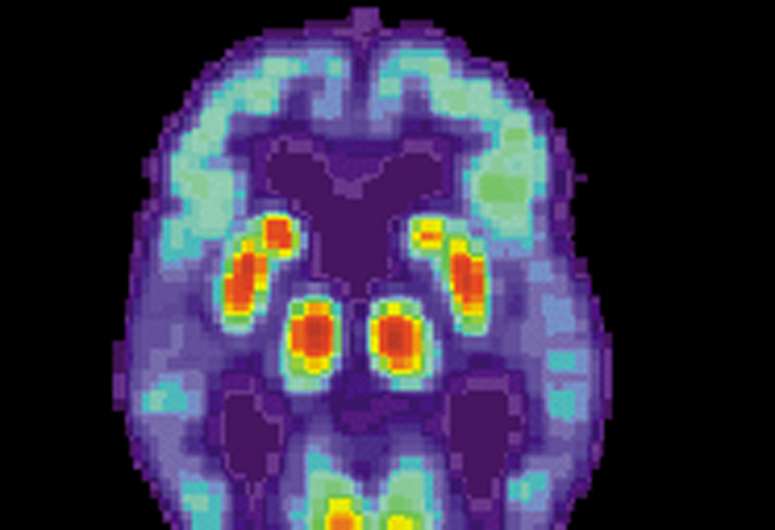PET scan of a human brain with Alzheimer's disease. Credit: public domain
InSysBio continues to investigate the mechanisms underlying Alzheimer's disease (AD) using the quantitative systems pharmacology (QSP) modeling approach. The QSP model describing the tau protein was published in PLOS ONE.
There is still no clear understanding of the driving force of AD progression. The main hypotheses are based on amyloid beta plaques or tau protein aggregation. Also known as microtubule-associated protein tau (MAPT), tau protein stabilizes the cytoskeleton in normal cells, but doesn't function properly in neurons of AD patients. It undergoes hyperphosphorylation and aggregates into neurofibrillary tangles within neurons. Normally, only some of the numerous phosphorylation sites of tau are phosphorylated. Therefore, drugs could potentially target pathological tau phosphorylation.
Different phosphorylation states contribute unequally in the pathology. So understanding the relative contribution of each kinase and phosphatase to phosphorylation of distinct sites is important in the search for principal drug targets. This was the goal of the work.
If a protein has n phosphorylation sites, there are 2n possible phosphorylation states. Furthermore, the sequence of protein phosphorylation and dephosphorylation processes is regulated in a complicated way. The model developers assumed that phosphorylation of distinct sites is partially independent. It allowed them to overcome the combinatorial explosion problem.
Four kinases (GSK3β, PKA, CDK5 and p38γ) and one phosphatase (PP2A) were selected from the plurality of tau (de)phosphorylating enzymes. Ten phosphorylation sites of specific interest for clinical research were selected from a few dozens of potentially phosphorylable sites of tau protein. This selection was based on the published experimental data. The modelers also incorporated so-called pseudo-residue, which described phosphorylation sites besides the 10 described above. This is the first effort of estimation of tau protein state sensitivity to key enzymes using real kinetic data.
"We've taken the first step in understanding of (de)phosphorylation patterns of each tau protein residue by different enzymes. Our model may suggest the role of each tau kinase or phosphatase plays in AD pathogenesis, as well as the most potent targets for its treatment," said Alexander Stepanov, the leading contributor of the article.
"The published model is another brick in the integrated QSP model, which may help to find the treatment of AD," said Tatiana Karelina, PhD, head of the Neurodegenerative Diseases modeling group at InSysBio.
More information: Alexander Stepanov et al, A mathematical model of multisite phosphorylation of tau protein, PLOS ONE (2018). DOI: 10.1371/journal.pone.0192519
Journal information: PLoS ONE
Provided by Institute for Systems Biology Moscow























